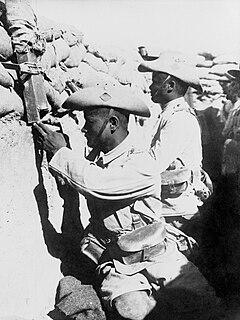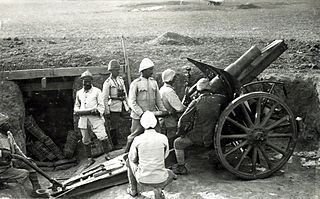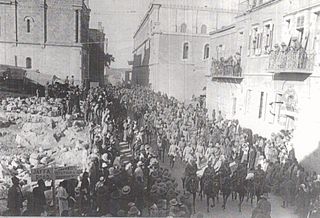 W
WThe Mesopotamian campaign was a campaign in the Middle Eastern theatre of World War I fought between the Allies represented by the British Empire, troops from Britain, Australia and the vast majority from British India, against the Central Powers, mostly from the Ottoman Empire.
 W
WThe Middle Eastern theatre of World War I saw action between 29 October 1914 and 30 October 1918. The combatants were, on one side, the Ottoman Empire, with some assistance from the other Central Powers; and on the other side, the British, the Russians and the French from among the Allied Powers. There were five main campaigns: the Sinai and Palestine Campaign, the Mesopotamian Campaign, the Caucasus Campaign, the Persian Campaign, and the Gallipoli Campaign. There were also several minor campaigns: Arab Campaign, and South Arabia Campaign.
 W
WThe Persian campaign or invasion of Iran was a series of military conflicts between the Ottoman Empire and the British Empire and Russian Empire in the Iranian Azerbaijan region of neutral Qajar Iran, beginning in December 1914 and ending with the Armistice of Mudros on 30 October 1918, as part of Middle Eastern theatre of World War I. The fighting also involved local Persian units, who fought against both the Entente and Ottoman forces in Iran. Collectively, the conflict proved to be a devastating experience for Persia. Over 2 million Persian civilians died in the conflict, mostly due to the Ottoman-perpetrated genocide and famine of 1917–1919, itself influenced by British and Russian actions. The Qajar government's inability to maintain the country's sovereignty during and immediately after the First World War led to a coup d'état in 1921 and Reza Shah's establishment of the Pahlavi dynasty.
 W
WThe South Persia Rifles, also known as SPR, was a Persian military force recruited by the British in 1916 and under British command. They participated in the Persian Campaign of World War I.
 W
WThe Arab Bureau was a section of the Cairo Intelligence Department established in 1916 during the First World War, and closed in 1920, whose purpose was the collection and dissemination of propaganda and intelligence about the Arab regions of the Middle East.
 W
WThe Arab Revolt or the Great Arab Revolt was a military uprising of Arab forces against the Ottoman Empire in the Middle Eastern theatre of World War I. On the basis of the McMahon–Hussein Correspondence, an agreement between the British government and Hussein bin Ali, Sharif of Mecca, the revolt was officially initiated at Mecca on June 10, 1916. The aim of the revolt was to create a single unified and independent Arab state stretching from Aleppo in Syria to Aden in Yemen, which the British had promised to recognize.
 W
WThe Assyrian Volunteers, was an ethnic Assyrian military force during WW1, led mainly by General Agha Petros Elia of Baz and several tribal leaders known as Maliks under the spiritual leadership of the Catholicos-Patriarch Mar Shimun Benyamin allied with the Entente Powers described by the English pastor and author William A. Wigram as Our Smallest Ally.
 W
WThe Basra Memorial is a Commonwealth War Graves Commission war memorial near Zubayr, Iraq. The memorial commemorates 40,682 Commonwealth forces members who died during the Mesopotamian Campaign, from the Autumn of 1914 to the end of August 1921, and whose graves are not known. The memorial was designed by Edward Prioleau Warren. It was unveiled by Gilbert Clayton on 27 March 1929. Originally located eight kilometres north of Basra, near the Shatt al-Arab River, it was moved southwest in 1997 to a battleground from the much more recent Gulf War.
 W
WThe Caucasus campaign comprised armed conflicts between the Russian Empire and the Ottoman Empire, later including Armenia, Azerbaijan, Georgia, the Mountainous Republic of the Northern Caucasus, the German Empire, the Central Caspian Dictatorship, and the British Empire, as part of the Middle Eastern theatre during World War I. The Caucasus campaign extended from the South Caucasus to the Armenian Highlands region, reaching as far as Trabzon, Bitlis, Mush and Van. The land warfare was accompanied by naval engagements in the Black Sea.
 W
WThe Egyptian Camel Transport Corps were a group of Egyptian camel drivers who supported the British Army in Egypt during the First World War's Sinai and Palestine Campaign. The work done by the 170,000 men of the Corps helped British war operations in the Sinai desert and in Palestine and Syria by transporting supplies to the troops in extreme geographic and weather conditions.
 W
WThe Egyptian Expeditionary Force (EEF) was a British Empire military formation, formed on 10 March 1916 under the command of General Archibald Murray from the Mediterranean Expeditionary Force and the Force in Egypt (1914–15), at the beginning of the Sinai and Palestine Campaign of the First World War.
 W
WThe Force in Egypt was a British Army formation established in August 1914 to administer garrisoning armed forces in Egypt at the beginning of the First World War. The force had the objective of protecting the Suez Canal and was originally commanded by Major General Julian Byng, but he was replaced by General J. Maxwell, who took command on 8 September 1914. Initially, the main threat to the Suez came from Germany and throughout the early months several of the force's elements were sent to Europe to take part in the fighting on the Western Front. On 5 November 1914, Britain and France declared war on the Ottoman Empire, after which the Force in Egypt faced a direct threat from Ottoman forces, which was realised in February 1915 with a raid on the Suez Canal. This threat remained until 1916 when the British forces went on the offensive.
 W
WThe Gallipoli campaign was a military campaign in the First World War that took place on the Gallipoli peninsula, from 17 February 1915 to 9 January 1916. The Entente powers, Britain, France and Russia, sought to weaken the Ottoman Empire, one of the Central Powers, by taking control of the Turkish straits. This would expose the Ottoman capital at Constantinople to bombardment by Allied battleships and cut it off from the Asian part of the empire. With Turkey defeated, the Suez canal would be safe, and a year-round Allied supply route could be opened through the Black Sea to warm water ports in Russia.
 W
WThe Pursuit to Haritan occurred between 29 September and 26 October 1918 when the XXI Corps and Desert Mounted Corps of the Egyptian Expeditionary Force (EEF) pursued the retreating remnants of the Yildirim Army Group advanced north from Damascus after that city was captured on 1 October during the final weeks of the Sinai and Palestine Campaign of the First World War. The infantry and corps cavalry advanced from Haifa and Acre to capture the Mediterranean ports at Beirut and Tripoli between 29 September and 9 October. These captures enabled the inland pursuit to be supplied when the Desert Mounted Corps' 5th Cavalry Division resumed the pursuit on 5 October. The cavalry division occupied one after the other, Rayak, Homs, Hama. Meanwhile, Prince Feisal's Sherifial Force which advanced on the cavalry division's right flank, attacked and captured Aleppo during the night of 25/26 October after an unsuccessful daytime attack. The next day the 15th Cavalry Brigade charged a retreating column and attacked a rearguard during the Charge at Haritan near Haritan which was at first reinforced but subsequently withdrew further north.
 W
WKermanshah operation was an offensive operation of units of the Russian 1st Caucasian Cavalry Corps in Western Iran from February - March 1916 during the Persian Campaign of the First World War.
 W
WThe Charge at Khan Ayash occurred on 2 October 1918 about 17 miles (27 km) north of Damascus after the pursuit to, and capture of Damascus, which followed the decisive Egyptian Expeditionary Force victory at the Battle of Megiddo on 25 September during the Sinai and Palestine Campaign of World War I. After Damascus had been encircled by Desert Mounted Corps on 30 September, the 3rd Light Horse Brigade advanced through the city on 1 October to charge and capture remnants of the Ottoman Yildirim Army Group withdrawing along the road north to Rayak and Homs.
 W
WThe Battle of Mughar Ridge, officially known by the British as the action of El Mughar, took place on 13 November 1917 during the Pursuit phase of the Southern Palestine Offensive of the Sinai and Palestine Campaign in the First World War. Fighting between the advancing Egyptian Expeditionary Force (EEF) and the retreating Yildirim Army Group, occurred after the Battle of Beersheba and the Third Battle of Gaza. Operations occurred over an extensive area north of the Gaza to Beersheba line and west of the road from Beersheba to Jerusalem via Hebron.
 W
WThe Battle of Nasiriyah was a battle in World War I that took place in the Mesopotamian city of Nasiriyah between British and Ottoman forces in July 1915. It was a pivotal battle in the Mesopotamian campaign of World War I and saw 5,000 British and Indian troops face off against a Turkish garrison of a similar number. British and Indian forces under the command of Lieutenant General Sir George Frederick Gorringe attacked Nasiriyah with the intention of protecting the British stronghold of Basra and destroying a major Turkish supply center in the region. British forces defeated the Turkish forces in Nasiriyah and it became the latest addition to a long string of successes against Ottoman forces in the campaign, coming right after the capture of Amara and the Battle of Qurna.
 W
WThe Raid on Nekhl was the second of three battles by British forces to recapture the Sinai Peninsula during the Sinai and Palestine Campaign of World War I. Egyptian Expeditionary Force (EEF) mounted forces travelled into the centre of the Sinai Peninsula to attack and push the last Ottoman Army garrisons back into Palestine.
 W
WConflicts took place in North Africa during World War I (1914–1918) between the Central Powers and the Entente and its allies. The Senussi of Libya sided with the Ottoman Empire and the German Empire against the British Empire and the Kingdom of Italy. On 14 November 1914, the Ottoman Sultan proclaimed a jihad and sought to create a diversion to draw British troops from the Sinai and Palestine Campaign. Italy wished to preserve its gains from the Italo-Turkish War. The Senussi Campaign took place in North Africa from 23 November 1915 to February 1917.
 W
WPalestine Railways was a government-owned railway company that ran all public railways in the League of Nations mandate territory of Palestine from 1920 until 1948. Its main line linked El Kantara in Egypt with Haifa. Branches served Jaffa, Jerusalem, Acre and the Jezreel Valley.
 W
WThe Stalemate in Southern Palestine was a six month standoff between the British Egyptian Expeditionary Force (EEF) and the Ottoman Army in World War I. The two hostile forces faced each other along the Gaza to Beersheba line during the Sinai and Palestine Campaign, with neither side able to force its opponent to withdraw. The stalemate began in April 1917 with the defeat of the EEF by the Ottoman Army at the Second Battle of Gaza and lasted until the EEF offensive began with the Battle of Beersheba on 31 October 1917.
 W
WThe Persian famine of 1917–1919 was a period of widespread mass starvation and disease in Persia (Iran) under the rule of the Qajar dynasty during World War I. The famine took place in the territory of Iran, which despite declaring neutrality was occupied by the forces of British, Russian and Ottoman empires. So far, few historians have researched the famine, making it an understudied subject of modern history.
 W
WThe Charge at Sheria took place on 7 November 1917 during the Battle of Hareira and Sheria when the 11th and 12th Light Horse Regiments charged a Yildirim Army Group rearguard in support of an attack by the 60th (London) Division during the Southern Palestine Offensive of the Sinai and Palestine Campaign in World War I.
 W
WThe Sinai and Palestine campaign of the Middle Eastern theatre of World War I was fought by the Arab Revolt and the British Empire, against the Ottoman Empire and its Imperial German allies. It started with an Ottoman attempt at raiding the Suez Canal in 1915, and ended with the Armistice of Mudros in 1918, leading to the cession of Ottoman Syria.
 W
WThe campaign in South Arabia during World War I was a minor struggle for control of the port city of Aden, an important way station for ships on their way from Asia to the Suez Canal. The British Empire declared war on the Ottoman Empire on 5 November 1914, and the Ottomans responded with their own declaration on 11 November. From the beginning, the Ottomans had planned an invasion of Britain's Aden Protectorate in cooperation with the local Arab tribes. The Ottomans had gathered in some strength on the Cheikh Saïd, a peninsula which juts out into the Red Sea towards the island of Perim.
 W
WThe city of Tabriz in the Persian region of Azerbaijan changed hands several times during World War I (1914–1918) between forces of the Ottoman Empire and the Russian Empire.
 W
WThe Second Transjordan attack on Shunet Nimrin and Es Salt, officially known by the British as the Second action of Es Salt and by others as the Second Battle of the Jordan, was fought east of the Jordan River between 30 April and 4 May 1918, during the Sinai and Palestine Campaign of the First World War. The battle followed the failure of the First Transjordan attack on Amman fought at the beginning April. During this second attack across the Jordan River, fighting occurred in three main areas. The first area in the Jordan Valley between Jisr ed Damieh and Umm esh Shert the Egyptian Expeditionary Force (EEF) defended their advanced position against an attack by units of the Seventh Army based in the Nablus region of the Judean Hills. The second area on the eastern edge of the Jordan Valley where the Ottoman Army garrisons at Shunet Nimrin and El Haud, on the main road from Ghoraniyeh to Amman were attacked by the 60th (London) Division many of whom had participated in the First Transjordan attack. The third area of fighting occurred after Es Salt was captured by the light horse brigades to the east of the valley in the hills of Moab, when they were strongly counterattacked by Ottoman forces converging on the town from both Amman and Nablus. The strength of these Ottoman counterattacks forced the EEF mounted and infantry forces to withdraw back to the Jordan Valley where they continued the Occupation of the Jordan Valley during the summer until mid September when the Battle of Megiddo began.